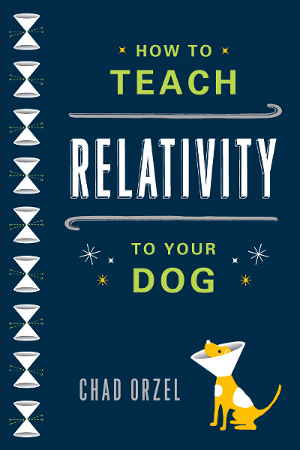Reviews: How to Teach Relativity to Your Dog
 How to Teach Relativity to Your Dog is a book that explains Einstein's theory of relativity in terms that even a dog can understand-- in fact, the dog does some of the explaining.
How to Teach Relativity to Your Dog is a book that explains Einstein's theory of relativity in terms that even a dog can understand-- in fact, the dog does some of the explaining.
Here's a collection of comments from and links to reviews of the book as they come in.
Traditional Media: Magazines, Newspapers, etc.:
“[A] compact and instructive walk through Einstein’s theory of relativity. . . . [T]he prose is breezy and straightforward, and the material well organized. . . . Relativity constantly amazes, and the glimpses of understanding provide rewarding and satisfying moments.”
“Unlike quantum physics, which remains bizarre even to experts, much of relativity makes sense. Thus, Einstein’s special relativity merely states that the laws of physics and the speed of light are identical for all observers in smooth motion. This sounds trivial but leads to weird if delightfully comprehensible phenomena, provided someone like Orzel delivers a clear explanation of why.”
Booklist:
“With canine humor and math- or physics-related jokes, Orzel keeps readers interested, while teaching the elements of physics that we promptly forgot after we took the test.”
“A clever introduction to the often intimidating concepts of special and general relativity, couched as a series of conversations between the author and his dog, Emmy. It may sound like a strange setup, but the somewhat kooky concept works well for explaining a field of physics that can sound, well, kooky to the uninitiated. . . . While keeping the math to a minimum, Orzel provides a clear and thorough primer. It might take some practice to start equating subatomic particles to running bunnies, but the reader will find that puzzling through the details is worth the effort.”
Reviews: How to Teach Physics to Your Dog
 How to Teach Physics to Your Dog is a book that explains quantum mechanics in terms that even a dog can understand-- in fact, the dog does some of the explaining.
How to Teach Physics to Your Dog is a book that explains quantum mechanics in terms that even a dog can understand-- in fact, the dog does some of the explaining.
Here's a collection of comments from and links to reviews of the book as they come in.
Traditional Media: Magazines, Newspapers, etc.:
What do dog treats and chasing squirrels have to do with quantum mechanics? Much more than you might imagine, as Orzel explains in this fun introduction to modern physics based on a "series of conversations" with his dog Emmy. Dogs make the perfect sounding board for physics talk, because they "approach the world with fewer preconceptions than humans, and always expect the unexpected." Physicist Orzel begins with the basics, explaining how light can be both particle and wave simultaneously--a bit like a dog that can split itself into two to chase a rabbit no matter which direction it runs. A look at Heisenberg's uncertainty principle begins with a hunt for a hypothetical bone. Schrödinger's cat becomes, of course, Schrödinger's dog. Quantum entanglement, quantum teleportation and virtual particles (composed, for example, of bunny-antibunny pairs) are all explained with the author's characteristic lighthearted touch. While Orzel's presentation may be a bit too precious for some, readers who've shied away from popular treatments of physics in the past may find his cheerful discussion a real treat.
Particle physicist Orzel has a smart and energetic German shepherd-mix, Emmy, who's interested in what he does for a living that keeps her in treats and kibble. So she asks him about it, and he tells her, with plenty of chaseable bunnies and squirrels illustratively standing-in for photons, electrons, and other particles. He cheerfully and uncommonly clearly explains particle-wave duality; Heisenberg's uncertainty principle (and the popular-media misuse of it); photon superposition and polarization; wave-function collapse and Bohr's strict discrimination between quantum and classical physics; the many-worlds view of quantum mechanics that defies wave-function collapse; the quantum Zeno effect; quantum tunneling (right through "solid" barriers); entanglement and how it enables teleportation (at the quantum scale, that is); virtual particles and quantum electrodynamics; and the fraudulence of quantum-mechanics-exploiting "free energy" and healing schemes. Emmy's attempts to apply her new knowledge practically (to catch squirrels and bunnies) keeps the conversation moving. It's hard to imagine a better way for the mathematically and scientifically challenged, in particular, to grasp basic quantum physics.
Around the Internet: Review Sites, Blogs, etc.:
Review at CultureLab, a blog from New Scientist:
[D]on't let Orzel's laid back nature or clever sense of humor fool you - he is explaining some pretty serious stuff. A level-headed and confident guide, he takes Emmy (and the reader) through everything from wave-particle duality and superpositions to quantum tunneling and the so-called "many worlds" interpretation ("many worlds, many treats").
Chad Orzel's How to Teach Physics to Your Dog is an absolutely delightful book on many axes: first, its subject matter, quantum physics, is arguably the most mind-bending scientific subject we have; second, the device of the book -- a quantum physicist, Orzel, explains quantum physics to Emmy, his cheeky German shepherd -- is a hoot, and has the singular advantage of making the mind-bending a little less traumatic when the going gets tough (quantum physics has a certain irreducible complexity that precludes an easy understanding of its implications); finally, third, it is extremely well-written, combining a scientist's rigor and accuracy with a natural raconteur's storytelling skill.
Casual physics intro books are quite possibly the hardest subgenre of physics books to write. Textbooks and further upper-level reading have expectations both of what you already know and how quickly you should pick up new material. Generally, those who pour through these types of books will read and reread until they've figured things out, regardless of how well the text actually explains things. Casual intro books, on the other hand, exist for a readership that has little devotion in comparison. Either the book is a near-perfect balance of new material paired with examples and explanations or it falls flat as readers loose interest.
How to Teach Physics to your Dog is one of these casual intro books with balance. Chad has always explained technical topics well on his blog but that alone doesn't provide much cohesive structure to draw in casual book readers. The glue here is the dialog with Emmy; a clear perspective from someone who has smart questions. If you're not reading along and thinking the same questions that Emmy verbalizes, you're thinking "Hey, that is a really interesting point!"
Review at Dog Spelled Forward:
Emmy’s love of critters plays a big part in the book, as she continually comes up with interesting applications of quantum physics in her efforts to get treats, locate bones, or get the “pesky squirrels.” Quantum physics can be some heavy stuff, and this book teaches you the basics without dumbing it down or putting you to sleep. Professor Orzel has a gift for funny dialogue and straightforward explanation. In addition to the entertaining conversations with Emmy, there are fascinating explanations of how the theories behind quantum mechanics were developed and how a few have been tested. There are also a few funny science fiction references – what discussion of quantum mechanics would be complete without some Star Trek?
I'd like to say that I'll include entertainingly negative reviews along with the positive stuff, a la Iain Banks's The Wasp Factory, but I can't promise anything...
How to Teach Physics to Your Dog is published by Scribner can be ordered from Amazon.com, IndieBound, Barnes and Noble, and Powell's.
How to Teach Relativity to Your Dog is published by Basic Books and can be ordered from Amazon, Barnes & Noble, Powell's.